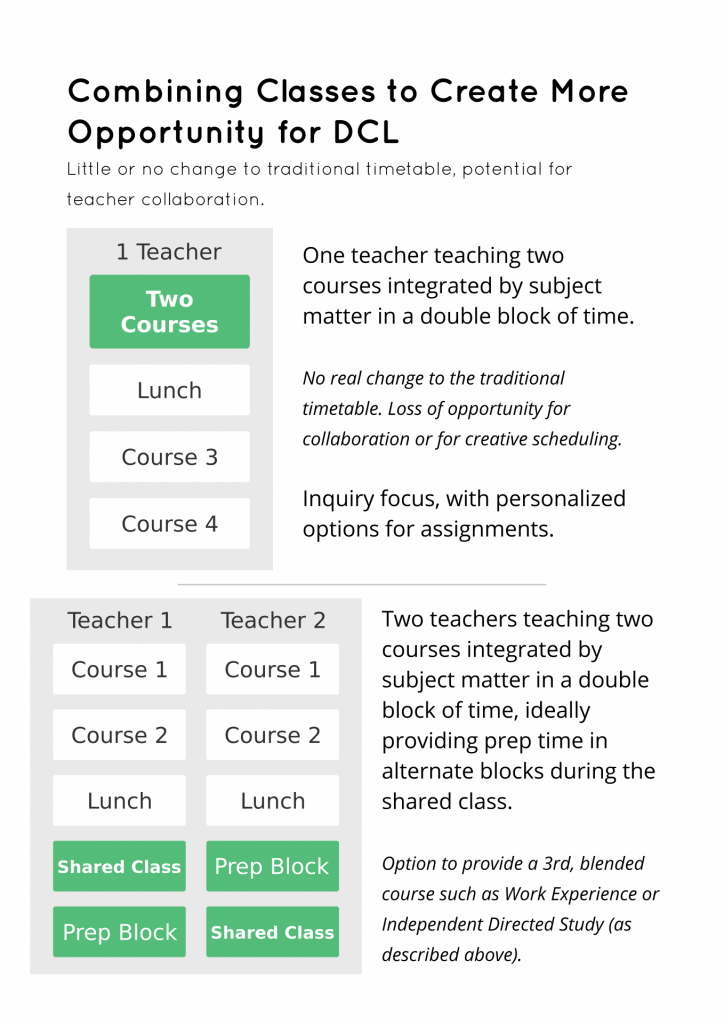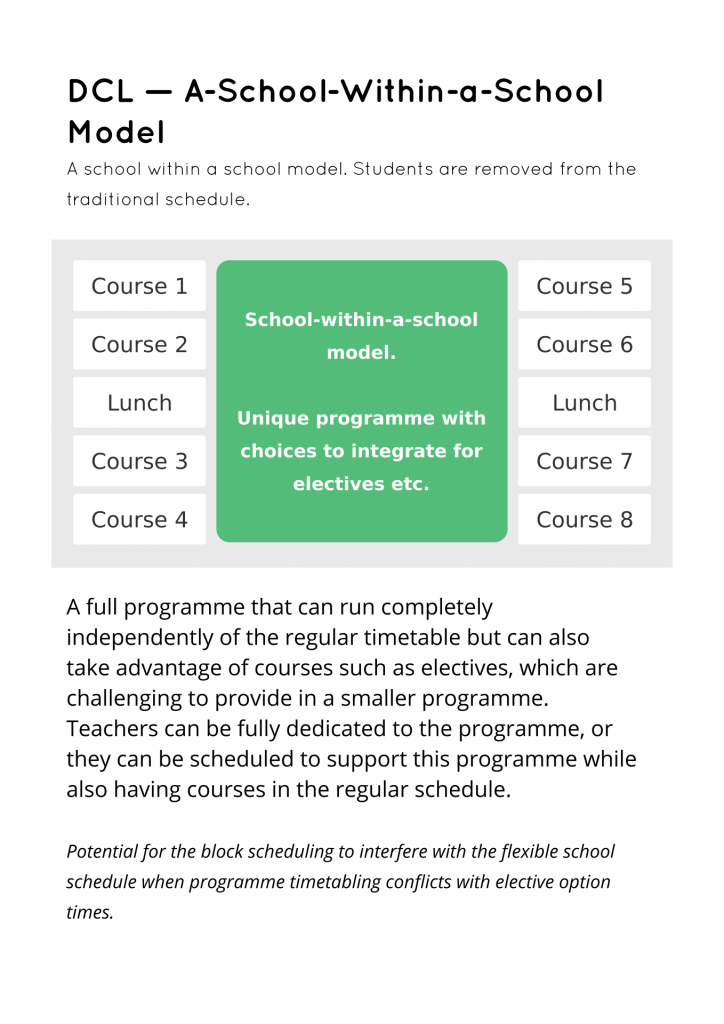DIY iHub
As a model school, there are several Inquiry Hub (iHub) features that we recommend for implementation, or other educators have expressed an interest in adapting—Foundations of Inquiry, Applications of Digital Learning, student leadership, and Dream Create Learn (DCL) time.
Foundations of Inquiry
We developed Foundations of Inquiry (FOI) 10 and 11 as Board Authority Approved (BAA) courses that share curricular competencies with the Applied Design, Skills, and Technologies curriculum. FOI 10 is a process-based course reflecting the necessary skills for productive participation in our society. Learners engage in student-led inquiries that are designed to be a combination of structured learning and opportunities to imagine, design, and innovate. FOI 11 goes beyond a general understanding of the inquiry process and prompts students to explore how inquiry is conducted in various disciplines and interdisciplinary research. For instance, how might inquiry in the social sciences differ from research in the physical sciences?
Adapting FOI 10 and 11 can be as straightforward as using our curriculum documents (once approved by the local school board) to create elective courses in any school. These two inquiry courses could be selected by students in the same way they might elect to take a music, drama, art, or technology course.
Required resources will depend on the interests of the students. For example, our students need video and audio equipment because they have in interest in film production. Depending on context, FOI can have a focus on entrepreneurship, visual art, computer programming, or politics, for example. It depends on what the students find interesting because inquiry projects are much more successful when students own it.
Applications of Digital Learning
We also created Applications of Digital Learning 10 (ADL) as another BAA course. ADL supports students to critically and ethically consume and create a wide variety of digital content, including websites, documents, images, social media posts, video, and podcasts. Communication is a central theme of the course and students will demonstrate an ability to express and exchange information, experiences, and ideas using various digital tools.
Adapting ADL 10 to individual school contexts is also straightforward. At present, all but one secondary school in SD43 requires their students to take ADL 10 (the last school will run the course next year). One school integrates ADL objectives, skills, and assignments across several other courses. Students record their progress and submit assignments using digital tools. The goal of the course is to help students develop the fluencies and attitudes of a global digital citizen.
Required resources include access to computers and the Internet for each learner.
Student Leadership
Regarding leadership, many schools have a culture where students are active within the community. At iHub, we try to go further by inviting students to intentionally shape the school identity. All of the most interesting projects at iHub are student-powered. For instance, we may be the only school in North America that organizes an original, student-designed live action role play (LARP) each year. Our students are also greatly involved in promoting the school through events they organize from beginning to end, such as iHub Spotlight, which showcases student-led projects; iHub Roadshow, which tours to surrounding middle schools to introduce the school to younger students; and iHub Open, Inquiry Hub’s annual open house.
Empowering students can be accomplished by involving students in community-building activities. It is also important that students have genuine opportunities to have an impact on the school. For example, we ask students to pitch for equipment and experiences to be acquired by the school, and most of our more interesting acquisitions are the result of consulting students with interests and expertise in the applicable area.
Required resources include time and a sponsor teacher.
Dream Create Learn Time
DCL time is the most significant and challenging change to make for other schools. Our version of DCL is 30 to 50% of a student’s week. During DCL, students work on assignments given to them by teachers, online components of their courses, or their inquiry projects. By allocating significant time for DCL, teachers must redesign their program to create time and space for students to work independently. By explicitly teaching inquiry learning as a course, we support students to work on projects of their own design. We assess skills and competencies rather than limiting our focus on learning content.
There are several ways that DCL may be successfully implemented in other schools. The simplest case begins with individual teachers implementing more DCL time in a specific class. A greater shift requires systemic change to provide students with a significant amount of DCL time. An innovative model disrupts the typical one-block-per-class schedule common in most high schools today.
Adding DCL time to a single class
This is the easiest way to implement DCL because the traditional timetable remains the same and each teacher is responsible for the change in their own class. Teachers can implement varying degrees of self-directed, personalized learning within a single class. The limitations include challenges around integrating subject matter when there is only one course being taught and limited flexibility in providing time for students to explore their own interests.
Combining classes to create more opportunity for DCL
In this instance, there is little or no change to a traditional timetable. One variation is to provide a single teacher with a double block of time to teach two integrated subjects, such as English and History. A second variation is to have two teachers teaching at least two courses where the subject matter and assignments can be integrated and DCL time embedded. In this case, teachers benefit from collaborating with each other. This is an excellent “entry level” approach to creating DCL time because it encourages flexible cross-curricular learning and, by combining two or more courses, encourages student-directed thematic projects.
Flex block model
In this model, the timetable is adapted to provide clearly defined time for students to be self-directed. Students have flex time built into their schedule, ideally to provide them with time to explore their interests. The flex block can be every day or there may be just one or two flex blocks each week. In addition to DCL time, a flex block can also be used to catch up on school work, meet with teachers, work in teams, or extend class projects. Flex time can also be used to work on Independent Directed Studies. Students do not necessarily need to meet with a specific teacher during flex block, but credit for work on self-directed projects would require an assigned teacher-mentor.
Partial Program—Implementing DCL within a ½ day or ½ year program
Another approach to DCL would provide students with a half-time cross-curricular program. Students would dedicate a semester, or half a semester for a full year, to a program which provides self-directed time. Online, blended, cross-curricular courses could allow more choice and flexibility during the program. As in all of these examples, explicitly teaching courses on Inquiry and Digital Learning can go a long way to creating opportunities for DCL time.
DCL—A school within a school model
This model now departs from a traditional schedule. A full program can run independently of the regular timetable, but can also take advantage of courses, such as electives, that are challenging to provide in a smaller program. Teachers can be fully dedicated to the program, or they can be scheduled to support this program while also having courses in the regular timetable as well. A potential advantage is to foster a small, creative, learning community within a larger school.
Flexible School Schedule Designed Around Time to Dream, Create, Learn
The most ambitious implementation is to design an entire school to support flexible, self-directed, cross-curricular learning. A student does not have a timetable defined by courses in a traditional block schedule. Instead, students may be grouped into teams or school-within-a-school programs depending on the types of problems they wish to solve, but not necessarily by their grade levels. Teachers have scheduled times when they would support passion projects and theme-based learning challenges designed by students and teachers. A Learning Commons or co-working space would provide support in different content areas. Moreover, students would develop core competencies, not just content-related competencies.
Notably, any of these models may be implemented without additional resources. After all, Inquiry Hub operates within the same conditions as other public schools. However, to become like iHub requires a similar school vision, a change in thinking, and the resiliency to make it work despite setbacks. Depending on the diversity of the learning community, success is more likely with sufficient resources for student services as well as funding for equipment needed for projects. For example, we might work with a community group to access cameras and other equipment to support a film project.
Although Inquiry Hub is a stand-alone small program today, it has the potential to be a fully developed system in a much larger school so that every student is given time and support to make their ideas come to life. A school that commits to adapting Foundations of Inquiry, Applications of Digital Learning, Student-led Projects, and Dream Create Learn time will begin to create their own version of the Inquiry Hub community. And every school could use an Inquiry Hub.






